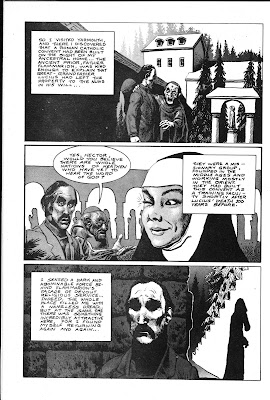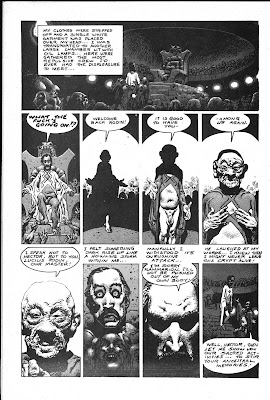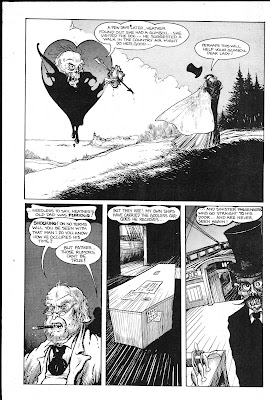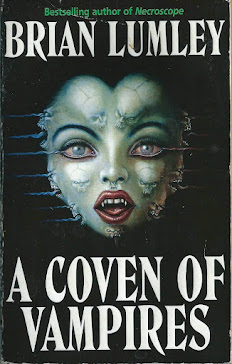Book Review: 'Thrill' by Barbara Petty
3 / 5 Stars
‘Thrill’ (240 pp) was published by Dell books in April 1977; the cover artist is uncredited.
The novel is set in Manhattan, ca. 1977. Katherine Fielding and Sandra Jurgenson are both in their late twenties, roommates, and co-workers at a magazine publisher. Katherine, who has the looks of a fashion model and an aristocratic background, is high-strung and prone to neuroses, while Sandra, who hails from the Midwest, is a down-to- earth ‘girl next door’.
After a difficult day at work, the girls decide to unwind by visiting a neighborhood bar called Ziggy’s. After deterring the usual lounge lizards, the girls decide to go home with a handsome bachelor named Ted Hanley. Once at Ted’s swank apartment (all the décor is in Earth Tones, natch) things take a turn for the worse – much worse – and the night ends in shock and horror.
As Katherine and Sandra try to cope with the aftermath of the night at Teds, the dynamic between them begins to change. No longer is Sandra the naïve New York City newcomer who serves as a dowdy complement to the striking Katherine. Now it is Sandra who makes the decisions and gives the orders to an increasingly fragile Katherine. And for Sandra, living on the edge is starting to take on a special allure…………
I found reading ‘Thrill’ to be a mixed reward. It certainly is effective in leveraging the social and workplace mores of the 70s, when harassment and sexist behavior by supervisors was part and parcel of the workplace and married men were quite comfortable with hitting on the female help.
Indeed, early on, the narrative leads the reader to believe that ‘Thrill’ is a novel about women exacting revenge on Male Chauvinist Pigs; a sort of Feminist reversal of Looking for Mr. Goodbar. But unfortunately, the novel moves aside from that direction and becomes a psychodrama that focuses on excavating buried emotional traumas.
Summing up, ‘Thrill’ is a quick read and offers an accurate, even nostalgic, portrait of New York City in the late 70s (complete with an elegant luncheon in the top floor of the World Trade Center). At times it succeeds as a psychological thriller. But when all is said and done it suffers from being too conventional, and represents a missed opportunity to do something offbeat and imaginative in the genre.
Monday, October 30, 2017
Friday, October 27, 2017
Demon Fire from Vampire Tales No. 3
Demon Fire
by Don McGregor (story) and Rich Buckler (art)
from Vampire Tales (Marvel / Curtis) No. 3, February 1974
Using a second-person point of view for a comic book narrative was relatively common in the 70s. What really sets this Morbius tale apart is some good artwork, including liberal use of Zip-A-Tone, by Rich Buckler who at the time was a one-man art studio for Marvel.
by Don McGregor (story) and Rich Buckler (art)
from Vampire Tales (Marvel / Curtis) No. 3, February 1974
Using a second-person point of view for a comic book narrative was relatively common in the 70s. What really sets this Morbius tale apart is some good artwork, including liberal use of Zip-A-Tone, by Rich Buckler who at the time was a one-man art studio for Marvel.
Labels:
Demon Fire
Tuesday, October 24, 2017
Book Review: Crossbearers
Book Review: 'Crossbearers' by Marc Brellen
1 / 5 Stars
‘Crossbearers’ (362 pp) was published by Leisure Books in 1988; the cover artist is uncredited. The novel’s copyright is held by Bruce Freshman, so the name ‘Marc Brellen’ likely is a pseudonym.
‘Crossbearers’ is physically and creatively deceptive. Physically deceptive in the sense that the cover at first appears to be a stepback cover with a die-cut keyhole; it fact, it isn’t. And the book is creatively deceptive in that while it appears to be a horror or suspense novel, in fact, it’s a tedious police procedural.
The novel is set in New York City in the late 80s. In the opening chapter, a high-ranking mobster is killed while attending a street fair. NYPD detective Barry Martin is assigned to the case. In his early 30s, Barry is the quintessential New York cop: cynical, skeptical, loathing the bureaucracy, but also loyal to his partners and unwilling to cut corners in the pursuit of justice.
Barry’s friend, Paul Tobin, is a priest at the parish that sponsored the street fair; he assists Barry in his investigation, which increasingly centers on the fact that a suspect wore a distinctive white cross around his neck. The advent of additional murders leads Barry and Paul to believe that a cult of crazed killers is loose in New York City………with a peculiar affinity for murdering individuals who are themselves criminals.
Barry Martin discovers that the actions of the cultists may be aided and abetted by senior clergy in the Catholic church……and perhaps by allies within the police department itself. But even as Martin acts to stop the depredations of the so-called ‘Crossbearers’, he himself has been targeted for elimination…………..
‘Crossbearers’ is a real dud. It was a struggle to finish.
Author Brellen simply isn’t up to the task; the novel reads like a first draft, with too many paragraphs suffering from difficulties with proper syntax:
While Doug and Roger gleefully watched a cartoon show on television, Joe and Carol plotted the kidnapping for Thursday night. The problem was how to bring the three victims together. Joe, impersonating a fellow officer, would telephone Jennifer Tobin to say that Barry had left a message to have her call Paul and Mary and meet them at his apartment at the proposed time, although the officer did not know for what purpose. Simple yet effective. And tomorrow was Thursday.
The novel relies heavily on dialogue passages, most of which are what reviewers call ‘wooden’. The narrative’s pacing is clumsy: romantic interactions between Barry Martin and Paul Tobin’s blind sister Jenny are related in numbing detail, while major events are disclosed within the span of a few short, often perfunctory sentences.
The book’s latter chapters increasingly rely on ever more contrived plot developments, deflating the final confrontation between Barry Martin and the Crossbearers. A closing chapter designed to expound on the nature of the conspiracy behind the actions of the cult serves only makes the plot seem even more confusing and poorly constructed.
Summing up, Leisure Books published its share of bad novels. This is one of them..........
1 / 5 Stars
‘Crossbearers’ (362 pp) was published by Leisure Books in 1988; the cover artist is uncredited. The novel’s copyright is held by Bruce Freshman, so the name ‘Marc Brellen’ likely is a pseudonym.
‘Crossbearers’ is physically and creatively deceptive. Physically deceptive in the sense that the cover at first appears to be a stepback cover with a die-cut keyhole; it fact, it isn’t. And the book is creatively deceptive in that while it appears to be a horror or suspense novel, in fact, it’s a tedious police procedural.
The novel is set in New York City in the late 80s. In the opening chapter, a high-ranking mobster is killed while attending a street fair. NYPD detective Barry Martin is assigned to the case. In his early 30s, Barry is the quintessential New York cop: cynical, skeptical, loathing the bureaucracy, but also loyal to his partners and unwilling to cut corners in the pursuit of justice.
Barry’s friend, Paul Tobin, is a priest at the parish that sponsored the street fair; he assists Barry in his investigation, which increasingly centers on the fact that a suspect wore a distinctive white cross around his neck. The advent of additional murders leads Barry and Paul to believe that a cult of crazed killers is loose in New York City………with a peculiar affinity for murdering individuals who are themselves criminals.
Barry Martin discovers that the actions of the cultists may be aided and abetted by senior clergy in the Catholic church……and perhaps by allies within the police department itself. But even as Martin acts to stop the depredations of the so-called ‘Crossbearers’, he himself has been targeted for elimination…………..
‘Crossbearers’ is a real dud. It was a struggle to finish.
Author Brellen simply isn’t up to the task; the novel reads like a first draft, with too many paragraphs suffering from difficulties with proper syntax:
While Doug and Roger gleefully watched a cartoon show on television, Joe and Carol plotted the kidnapping for Thursday night. The problem was how to bring the three victims together. Joe, impersonating a fellow officer, would telephone Jennifer Tobin to say that Barry had left a message to have her call Paul and Mary and meet them at his apartment at the proposed time, although the officer did not know for what purpose. Simple yet effective. And tomorrow was Thursday.
The novel relies heavily on dialogue passages, most of which are what reviewers call ‘wooden’. The narrative’s pacing is clumsy: romantic interactions between Barry Martin and Paul Tobin’s blind sister Jenny are related in numbing detail, while major events are disclosed within the span of a few short, often perfunctory sentences.
The book’s latter chapters increasingly rely on ever more contrived plot developments, deflating the final confrontation between Barry Martin and the Crossbearers. A closing chapter designed to expound on the nature of the conspiracy behind the actions of the cult serves only makes the plot seem even more confusing and poorly constructed.
Summing up, Leisure Books published its share of bad novels. This is one of them..........
Labels:
Crossbearers
Saturday, October 21, 2017
Book Review: Blood Snarl
Book Review: 'Blood Snarl' by Ivor Watkins
3 / 5 Stars
‘Blood Snarl’ first was published in the UK in 1980 as The Bloodsnarl. In the US, this Signet paperback (345 pp), retitled ‘Blood Snarl’, was released in January, 1982; the cover artist is uncredited.
‘Blood Snarl’ was UK author Ivor Watkins’s first novel; according to his bio, he had worked as a journalist on Fleet Street before changing careers to public relations. He published a second horror novel, ‘Demon’, in 1983.
‘Blood Snarl’ is set in the near-future (i.e., ca. 2000). The advent of Global Cooling means that the British Isles are seized by one of the coldest winters in living memory. England is economically depleted; snow and ice have reduced travel, emptied the government budget, fomented outbreaks of influenza, and reduced the standard of living to a point reminiscent of the days of postwar Austerity.
As bad as things are in England, they are worse in Northern Scotland, where ‘Blood’ takes place. The village of Elphin is the novel’s central location, and Elphin and the surrounding highlands are covered in waist-deep snow and freezing temperatures. Roads and railways are barely passable, and the government - preoccupied with events in England - is quite indifferent about the troubles afflicting Scotland.
The severe weather has led the red deer population to migrate from the country down to the village, where they search for edible vegetation. With their prey moving to areas of human habitation, the wolves of the highlands must follow. But one pack is led by an extraordinary wolf……….a wolf named Darkmind. Weighing two hundred pounds, intelligent, and cunning, Darkmind sees no reason why two-legged prey cannot be taken.
As Winter settles its hold on Elphin, the howling of wolves in the night brings with it a realization that northern Scotland has reverted to an earlier, less assured, era when primitive man vied with Canis lupus for the apex of the food chain. If wildlife ecologist Richard Unthank cannot find a way to deter the advance of the predators, the citizens of Elphin soon will find themselves caught in a desperate struggle for survival…………..
‘Blood Snarl’ is a readable novel, and one of the better entries in the ‘When Animals Attack’ sub-genre of horror novels of the 70s and 80s. Watkins wisely uses a straightforward prose style, leavened here and there with the occasional metaphor or simile (‘The weather was as fickle as a jealous woman’). He also takes care to involve the snowbound landscape of the Scottish highlands – and its real-life isolated farms, villages, forests, lochs, and parklands - as a quasi-character in and of itself, giving the novel an atmosphere conducive to its depiction of a senescent civilization beset with the forces of a resurgent Mother Nature.
Where ‘Blood’ shows strains is in its length; at 345 pages, it would greatly have benefited from being reduced in length by 75 – 100 pages. By the book’s halfway point the narrative grows increasingly reliant on generating suspense via having its Scottish villagers, and arrogant Americans, ever more willing to venture out into the snow alone and unarmed. Sub-plots involving romantic entanglements among the lead characters, the self-serving escapades of UK politicians, and the low morals of Fleet Street publishers also begin to wear. The novel’s last-chapter climax seems perfunctory and unconvincing.
The verdict ? ‘Blood Snarl’ is best described as The Wolfen Visit Scotland. I can’t say it’s a must-have, but if you see a copy on the shelf while wandering the aisles of your favorite used bookstore, it may be worth picking up.
3 / 5 Stars
‘Blood Snarl’ first was published in the UK in 1980 as The Bloodsnarl. In the US, this Signet paperback (345 pp), retitled ‘Blood Snarl’, was released in January, 1982; the cover artist is uncredited.
‘Blood Snarl’ was UK author Ivor Watkins’s first novel; according to his bio, he had worked as a journalist on Fleet Street before changing careers to public relations. He published a second horror novel, ‘Demon’, in 1983.
‘Blood Snarl’ is set in the near-future (i.e., ca. 2000). The advent of Global Cooling means that the British Isles are seized by one of the coldest winters in living memory. England is economically depleted; snow and ice have reduced travel, emptied the government budget, fomented outbreaks of influenza, and reduced the standard of living to a point reminiscent of the days of postwar Austerity.
As bad as things are in England, they are worse in Northern Scotland, where ‘Blood’ takes place. The village of Elphin is the novel’s central location, and Elphin and the surrounding highlands are covered in waist-deep snow and freezing temperatures. Roads and railways are barely passable, and the government - preoccupied with events in England - is quite indifferent about the troubles afflicting Scotland.
The severe weather has led the red deer population to migrate from the country down to the village, where they search for edible vegetation. With their prey moving to areas of human habitation, the wolves of the highlands must follow. But one pack is led by an extraordinary wolf……….a wolf named Darkmind. Weighing two hundred pounds, intelligent, and cunning, Darkmind sees no reason why two-legged prey cannot be taken.
As Winter settles its hold on Elphin, the howling of wolves in the night brings with it a realization that northern Scotland has reverted to an earlier, less assured, era when primitive man vied with Canis lupus for the apex of the food chain. If wildlife ecologist Richard Unthank cannot find a way to deter the advance of the predators, the citizens of Elphin soon will find themselves caught in a desperate struggle for survival…………..
‘Blood Snarl’ is a readable novel, and one of the better entries in the ‘When Animals Attack’ sub-genre of horror novels of the 70s and 80s. Watkins wisely uses a straightforward prose style, leavened here and there with the occasional metaphor or simile (‘The weather was as fickle as a jealous woman’). He also takes care to involve the snowbound landscape of the Scottish highlands – and its real-life isolated farms, villages, forests, lochs, and parklands - as a quasi-character in and of itself, giving the novel an atmosphere conducive to its depiction of a senescent civilization beset with the forces of a resurgent Mother Nature.
Glencoe, Scotland, in Winter
Where ‘Blood’ shows strains is in its length; at 345 pages, it would greatly have benefited from being reduced in length by 75 – 100 pages. By the book’s halfway point the narrative grows increasingly reliant on generating suspense via having its Scottish villagers, and arrogant Americans, ever more willing to venture out into the snow alone and unarmed. Sub-plots involving romantic entanglements among the lead characters, the self-serving escapades of UK politicians, and the low morals of Fleet Street publishers also begin to wear. The novel’s last-chapter climax seems perfunctory and unconvincing.
The verdict ? ‘Blood Snarl’ is best described as The Wolfen Visit Scotland. I can’t say it’s a must-have, but if you see a copy on the shelf while wandering the aisles of your favorite used bookstore, it may be worth picking up.
Labels:
Blood Snarl
Thursday, October 19, 2017
Monday, October 16, 2017
Book Review: Next, After Lucifer
Book Review: 'Next, After Lucifer' by Daniel Rhodes
4 / 5 Stars
‘Next, After Lucifer’ (258 pp) was published by Tor Books in July, 1988.
‘Next’ is one of those horror novels in which Ancient Evil arises from a tomb / Native American burial ground / ruined castle / haunted house and wreaks havoc among the unsuspecting citizens of whatever town, or village, or otherwise wretched habitation has the misfortune to lie in close proximity. But it is certainly a cut above the standard-issue novels in this genre.
The story is set in the late 80s in Provence, France. John McTell, an American professor of medieval history, has rented a villa in the countryside not far from the coast of the Mediterranean Sea. Despite the villa’s idyllic character, the restaurants and churches of the charming little village located a short drive away, and the warm Summer air, McTell finds himself inexplicably drawn to the unsettling ruins of the nearby medieval fortress of Montservrain.
McTell learns from the village priest that in the early 13th century, Montservrain was a fortress held by a group of Knights Templars, led by a one-eyed giant named Guilhem de Courdeval. De Courdeval, according to local legend, was a figure of immense evil, given to offering blood sacrifices to demons in exchange for arcane knowledge. Only after the peasant population of the area surrounding the fortress was depleted from de Courdeval’s machinations did the Church dispatch a contingent of Inquisitors to overwhelm the castle, and burn de Courdeval at the stake.
McTell explores the ruins of Montservrain and finds – or perhaps is led to find ? - a long-buried artifact that likely belonged to de Courdeval. Soon McTell’s studies of the artifact become more than scholarly in nature, as evil influences start to take hold not just of him, but of the village………
‘Next, After Lucifer’ benefits first and foremost from author Rhodes’s writing, which flows smoothly and is devoid of the contrivances and artifice that tend to blight many horror novels of the 80s. For example, 'Next' has its obligatory hallucination / nightmare sequences, but these are restrained and do not overwhelm the narrative.
4 / 5 Stars
‘Next, After Lucifer’ (258 pp) was published by Tor Books in July, 1988.
‘Next’ is one of those horror novels in which Ancient Evil arises from a tomb / Native American burial ground / ruined castle / haunted house and wreaks havoc among the unsuspecting citizens of whatever town, or village, or otherwise wretched habitation has the misfortune to lie in close proximity. But it is certainly a cut above the standard-issue novels in this genre.
The story is set in the late 80s in Provence, France. John McTell, an American professor of medieval history, has rented a villa in the countryside not far from the coast of the Mediterranean Sea. Despite the villa’s idyllic character, the restaurants and churches of the charming little village located a short drive away, and the warm Summer air, McTell finds himself inexplicably drawn to the unsettling ruins of the nearby medieval fortress of Montservrain.
McTell learns from the village priest that in the early 13th century, Montservrain was a fortress held by a group of Knights Templars, led by a one-eyed giant named Guilhem de Courdeval. De Courdeval, according to local legend, was a figure of immense evil, given to offering blood sacrifices to demons in exchange for arcane knowledge. Only after the peasant population of the area surrounding the fortress was depleted from de Courdeval’s machinations did the Church dispatch a contingent of Inquisitors to overwhelm the castle, and burn de Courdeval at the stake.
McTell explores the ruins of Montservrain and finds – or perhaps is led to find ? - a long-buried artifact that likely belonged to de Courdeval. Soon McTell’s studies of the artifact become more than scholarly in nature, as evil influences start to take hold not just of him, but of the village………
‘Next, After Lucifer’ benefits first and foremost from author Rhodes’s writing, which flows smoothly and is devoid of the contrivances and artifice that tend to blight many horror novels of the 80s. For example, 'Next' has its obligatory hallucination / nightmare sequences, but these are restrained and do not overwhelm the narrative.
The cast of characters and locales are small and circumscribed, but Rhodes keeps his plot from becoming tedious by adroitly shifting the narrative from one incident to another; he also offers some blackly humorous insights into village life, and the perils of having relatives with too much money and time on their hands come to visit your summer villa.
The ‘evil spirit’ aspect of the novel avoids being trite by virtue of representing all manner of medieval atrocities, these being depicted with sufficient gruesomeness to make the reader wince.
The verdict ? ‘Next, After Lucifer’ is an effective novel of the occult. I would have given it five stars but for the ending, which pulls its punches in order to set up a sequel (‘Adversary’, 1988). But this is a solid four star read, and well worth picking up.
The ‘evil spirit’ aspect of the novel avoids being trite by virtue of representing all manner of medieval atrocities, these being depicted with sufficient gruesomeness to make the reader wince.
The verdict ? ‘Next, After Lucifer’ is an effective novel of the occult. I would have given it five stars but for the ending, which pulls its punches in order to set up a sequel (‘Adversary’, 1988). But this is a solid four star read, and well worth picking up.
Saturday, October 14, 2017
Thursday, October 12, 2017
A Gothic Tale Part One
A Gothic Tale
Part One
by Greg Irons
from Skull No. 6, 1972
'A Gothic Tale' ran as a two-part story taking up the entire contents of issue 6 of Skull comics. Featuring great artwork by Greg Irons and Richard Corben, 'A Gothic Tale' matched the best of any story then appearing in the Warren magazines of the early 70s, and went one better in terms of graphic, 'adults only' content.
I'm posting Part One here; Part Two will be posted shortly.
Part One
by Greg Irons
from Skull No. 6, 1972
'A Gothic Tale' ran as a two-part story taking up the entire contents of issue 6 of Skull comics. Featuring great artwork by Greg Irons and Richard Corben, 'A Gothic Tale' matched the best of any story then appearing in the Warren magazines of the early 70s, and went one better in terms of graphic, 'adults only' content.
I'm posting Part One here; Part Two will be posted shortly.
Labels:
A Gothic Tale Part One
Subscribe to:
Posts (Atom)















































































